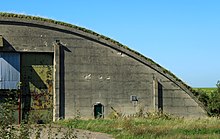Hullavington Airfield
|
Hullavington Airfield |
|||||||||||||||
|---|---|---|---|---|---|---|---|---|---|---|---|---|---|---|---|

Hangar at the former RAF Hullavington in 2012
|
|||||||||||||||
| Summary | |||||||||||||||
| Airport type | Military | ||||||||||||||
| Owner | Ministry of Defence | ||||||||||||||
| Operator | Royal Air Force | ||||||||||||||
| Location | Hullavington, Wiltshire | ||||||||||||||
| Built | 1937 | ||||||||||||||
| In use | 1937-2016 | ||||||||||||||
| Elevation AMSL | 201 ft / 104 m | ||||||||||||||
| Coordinates | 51°31′30″N 002°08′00″W / 51.52500°N 2.13333°WCoordinates: 51°31′30″N 002°08′00″W / 51.52500°N 2.13333°W | ||||||||||||||
| Map | |||||||||||||||
| Location in Wiltshire | |||||||||||||||
| Runways | |||||||||||||||
|
|||||||||||||||
Hullavington Airfield (IATA: —, ICAO: EGDV) is an airfield in Hullavington, near Chippenham, Wiltshire, England. The site is the former RAF Hullavington a Royal Air Force station.
The airfield is due to formally close in the coming years. As of 1 September 2016, the airfield was closed to flying.
The site was opened on 14 June 1937 with No 9 Flying Training School arriving from RAF Thornaby on 10 July in the same year.Leonard Cheshire V.C. trained here in 1939. With the beginning of the Second World War top officers from allied nations came to Hullavington to share ideas and ways of using aircraft. Ten Blenheims from No 114 Squadron arrived at the base on 1 September 1939, and were later joined by seven from No 139 Squadron. This was a safety move as a sustained attack was expected at the East Anglian bomber bases on the announcement of war being declared. As this didn't happen, all the Blenheims had departed Hullavington by 16 September 1939. An effective Met. Office was also stationed at Hullavington. An aircraft which left every day at dawn flew at various heights in order to send data back for the Met. Office to assess the weather.
In 1970, RAF Hullavington hosted the World Aerobatic Championships.
In 1992, the entire airfield was designated as a conservation area. English Heritage (now Historic England) later stated that "It embodies, to a unique degree, the improved architectural quality associated with the post-1934 expansion of the RAF. Most of the original buildings have survived and form a particularly coherent and well-ordered ensemble."
In 1993, one Senior Aircraftman was convicted of arson and sent to jail for 5 years. His accomplice received a fine of £1000. The hangar was the location of all the parachutes for the armed services, and the damage and loss of stock affected morale at the base.
...
Wikipedia

